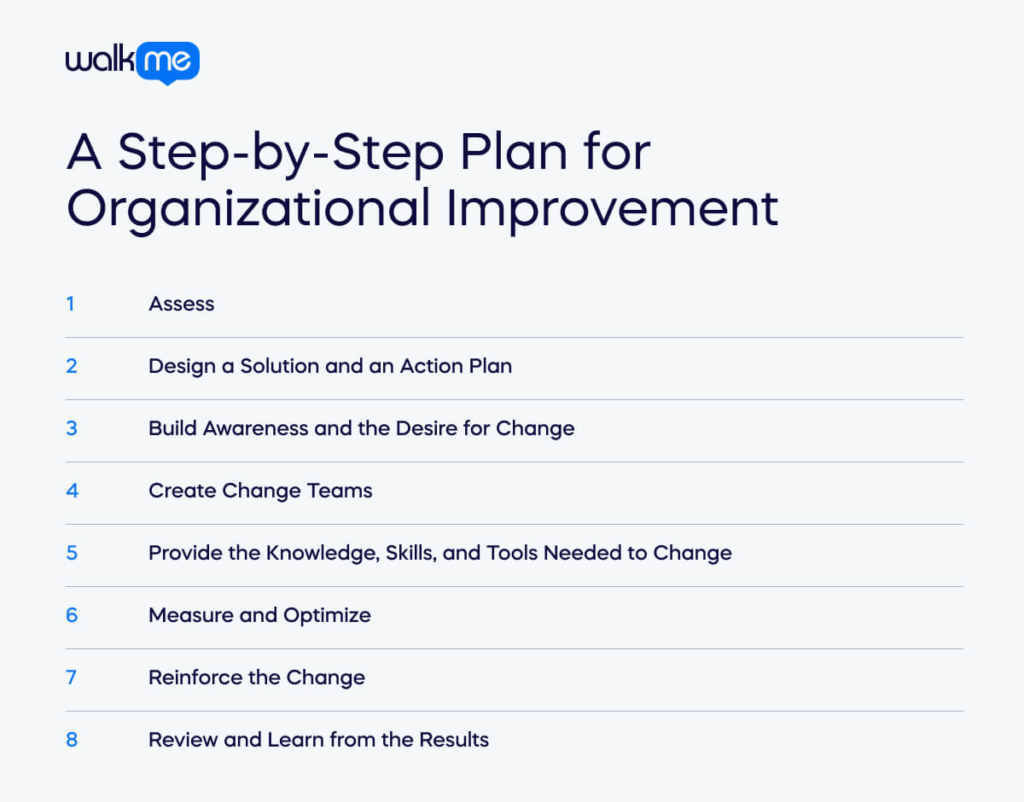For business professionals who want to know how to improve an organization, performance should be a top priority.
A number of factors contribute to organizational performance, including:
- The workforce
- Organizational culture
- Organizational strategy
- Digital maturity
- Business process efficiency
Among others.
To improve an organization’s performance, it’s necessary to analyze the organization’s effectiveness, understand weaknesses, and design appropriate fixes.
How to Improve an Organization: Performance Enhancement, Step-by-Step
Improving an organization’s effectiveness, productivity, and performance almost always involves organizational change.
The type of organizational change will depend, of course, on which performance issues are being addressed.
Below, we will look at a step-by-step change management approach designed to:
- Assess organizational effectiveness
- Identify performance issues and opportunities
- Develop an organizational improvement plan
- Mitigate risks and avoid obstacles
- Create and execute a change plan
With careful analysis, planning, and execution, the right change plan can solve performance issues and generate productivity gains throughout the organization.
A Step-by-Step Plan for Organizational Improvement

Enhancing an organization’s performance, as mentioned, involves some type of organizational change.
For that reason, business process improvements should draw heavily from the discipline of change management.
Change management tends to focus on people – motivating employees, earning their support, circumventing resistance, and so forth.
After all, people drive change … without their commitment, change initiatives will make little or no progress.
The change process outlined below is based on some of the most widely used change management frameworks.
1. Assess
Assessment and analysis is the very first step in any business project.
Areas to assess include:
- The specific performance problem
- An organization’s readiness and willingness to change
- Technical capabilities, knowledge, and abilities
- Employee and executive sentiment
Laying this groundwork is essential to developing an appropriate solution.
2. Design a Solution and an Action Plan
After identifying the root cause of performance issues, the appropriate personnel should propose a solution.
Here are a few examples:
- Ineffective management depresses employee productivity and engagement. One solution: training and education for managers.
- Obsolete technology causes poor sales productivity. One solution: adopting new marketing software.
- Technical support costs are high for a particular software product. One solution: a digital adoption platform (DAP) that simplifies user onboarding.
Every solution should also be accompanied by:
- A step-by-step roadmap for rolling out the change
- A change strategy that focuses on motivating and training employees
- Metrics to track progress and make adjustments as needed
Organizational changes should be managed just as other projects are managed.
They should have goals, milestones, a set schedule, and delegated roles.
3. Build Awareness and the Desire for Change
A crucial step in any organizational improvement project is building awareness, desire, and a sense of urgency.
If employees don’t understand the need for change, they will be more likely to resist that change.
There are a few ways to minimize resistance and maximize support:
- Explain the reasons for the change in detail
- Sell employees on how the change will benefit them personally
- Listen to employee feedback and make sure they feel heard
Employees should, in other words, feel that they are participating in a change program.
This will minimize feelings of alienation, besiegement, and other negative reactions.
4. Create Change Teams
Change management roles can include:
- The core change team, who is responsible for coordinating and managing the change project
- Managers, who guide their employees and stay connected to the change team
- Outside vendors, specialists, or consultants who offer expertise
- Executives and senior managers who can support, sponsor, and even lead a project
It is important that every role and responsibility is clearly defined, so each party knows what is expected of them.
5. Provide the Knowledge, Skills, and Tools Needed to Change
Improving an organization’s performance often requires new tools, skills, workflows, processes, or procedures.
Effective employee training, therefore, is essential for success.
For instance, if a business adopts new customer service procedures, employees must learn those new processes.
Or if a business adopts a new digital platform, employees must become proficient with that software in order to be productive.
6. Measure and Optimize
Change management metrics will depend on a project’s goals.
For instance, if an organization wants to improve employee performance by adopting new training software, good metrics could include:
- Time-to-competency
- Proficiency levels
- Productivity and output
- Engagement
The right metrics can offer insight into the success of a project, as well as demonstrate the value and ROI of that specific project.
7. Reinforce the Change
Employees can easily slip back into old habits, even after a change project is completed.
Reinforcement ensures that changes – and performance improvements – stick.
There are a few ways to reinforce changes, such as:
- Retraining after a project has been completed
- Rewards and incentives
- Ongoing communication
Change managers should continue to monitor their project’s progress and take action if they see workers reverting to old behavior.
8. Review and Learn from the Results
Finally, an organization should review the results of its improvement project.
Data, analytics, and feedback can offer insight into what worked, what didn’t, and what can be improved upon in future change projects.
No project will deliver perfect results – but with careful planning and an appropriate strategy, change management can help improve organizational performance across many areas.

